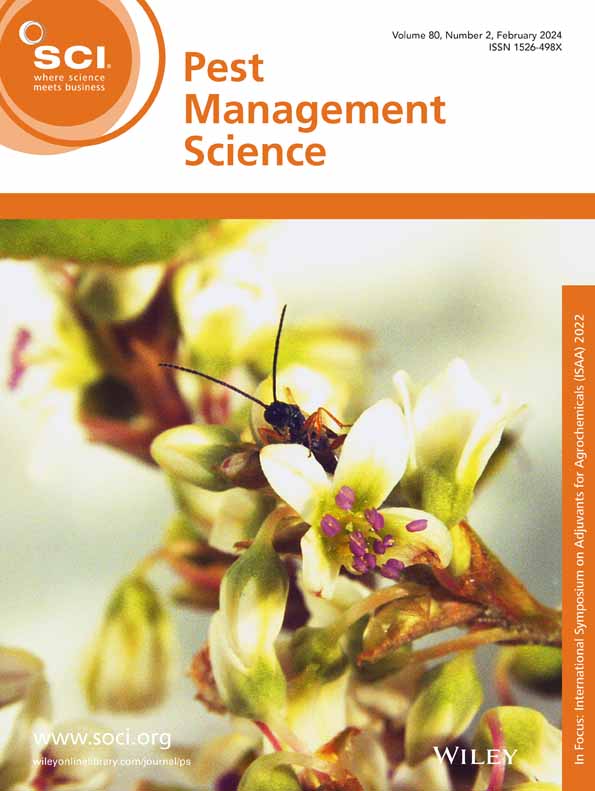Enhancing plant resistance to tobacco mosaic virus through the combined application of Verticillium dahliae Aspf2‐like protein and microelements
IF 3.8
1区 农林科学
Q1 AGRONOMY
Shichen Li, Fupeng Mei, Waqar Ahmed, Tao Jiang, Linyuan Yang, Xiaodong Hu, Meiwei Zhao, Xiaoci Peng, Ren Peng, Yingfen Yang, Wei Zhang, Mingmin Li, Zhengxiong Zhao
求助PDF
{"title":"Enhancing plant resistance to tobacco mosaic virus through the combined application of Verticillium dahliae Aspf2‐like protein and microelements","authors":"Shichen Li, Fupeng Mei, Waqar Ahmed, Tao Jiang, Linyuan Yang, Xiaodong Hu, Meiwei Zhao, Xiaoci Peng, Ren Peng, Yingfen Yang, Wei Zhang, Mingmin Li, Zhengxiong Zhao","doi":"10.1002/ps.8824","DOIUrl":null,"url":null,"abstract":"BACKGROUNDTobacco mosaic virus (TMV) poses a significant threat to global agriculture, infecting economically vital crops such as tobacco, tomato, pepper, and potato. Previous studies have suggested that the <jats:italic>Verticillium dahliae</jats:italic> Aspf2‐like protein (VDAL) enhances plant resistance to TMV. This study investigated the preventive and therapeutic effects of VDAL, with and without microelements, on TMV resistance by analyzing plant hormone levels, defense related enzyme activities, and transcriptomic responses.RESULTSPlants were subjected to six experimental treatments: CK0 (untreated control, no TMV or VDAL treatment), CK (TMV inoculated control), T1 (preventive VDAL treatment), T2 (preventive VDAL + microelements), CT1 (therapeutic VDAL treatment), and CT2 (therapeutic VDAL + microelements). TMV inoculation (CK) significantly increased (<jats:italic>P</jats:italic> < 0.05) TMV content, jasmonic acid (JA), salicylic acid (SA) levels, and activities of defense related enzymes, including benzoic acid 2‐hydroxylase (BA2H), peroxidase (POD), polyphenol oxidase (PPO), and superoxide dismutase (SOD), compared to CK0. Both preventive treatments (T1 and T2) effectively reduced TMV content and enhanced JA, SA, and defense related enzyme activities. Notably, the microelement‐supplemented preventive treatment (T2) showed 37.73% greater reduction in TMV content compared to T1. Similarly, the therapeutic applications, CT2 reduced the TMV content by 32.50% than CT1. Treatments T2 and CT2 also increased the contents of JA by 5.48% and 2.88%, respectively compared to their respective controls. Transcriptomic analysis revealed that these treatments activated plant–pathogen interaction pathways and pathogen‐associated molecular pattern‐triggered immunity (<jats:italic>PTI</jats:italic>), with significant upregulation of key defense related genes (e.g., <jats:italic>CALM</jats:italic>, <jats:italic>BAK1</jats:italic>, <jats:italic>PTI6</jats:italic>, and <jats:italic>WRKY33</jats:italic>), indicating a robust antiviral defense response.CONCLUSIONOverall, we conclude that the synergistic application of VDAL and microelements significantly enhances plant resistance to TMV through coordinated activation of phytohormone signaling, defense enzymes, and immune‐related gene expression. This combined approach offers an effective, eco‐friendly alternative for sustainable management of viral diseases in agricultural crops. © 2025 Society of Chemical Industry.","PeriodicalId":218,"journal":{"name":"Pest Management Science","volume":"33 1","pages":""},"PeriodicalIF":3.8000,"publicationDate":"2025-04-21","publicationTypes":"Journal Article","fieldsOfStudy":null,"isOpenAccess":false,"openAccessPdf":"","citationCount":"0","resultStr":null,"platform":"Semanticscholar","paperid":null,"PeriodicalName":"Pest Management Science","FirstCategoryId":"97","ListUrlMain":"https://doi.org/10.1002/ps.8824","RegionNum":1,"RegionCategory":"农林科学","ArticlePicture":[],"TitleCN":null,"AbstractTextCN":null,"PMCID":null,"EPubDate":"","PubModel":"","JCR":"Q1","JCRName":"AGRONOMY","Score":null,"Total":0}
引用次数: 0
引用
批量引用
Abstract
BACKGROUNDTobacco mosaic virus (TMV) poses a significant threat to global agriculture, infecting economically vital crops such as tobacco, tomato, pepper, and potato. Previous studies have suggested that the
Verticillium dahliae Aspf2‐like protein (VDAL) enhances plant resistance to TMV. This study investigated the preventive and therapeutic effects of VDAL, with and without microelements, on TMV resistance by analyzing plant hormone levels, defense related enzyme activities, and transcriptomic responses.RESULTSPlants were subjected to six experimental treatments: CK0 (untreated control, no TMV or VDAL treatment), CK (TMV inoculated control), T1 (preventive VDAL treatment), T2 (preventive VDAL + microelements), CT1 (therapeutic VDAL treatment), and CT2 (therapeutic VDAL + microelements). TMV inoculation (CK) significantly increased (
P < 0.05) TMV content, jasmonic acid (JA), salicylic acid (SA) levels, and activities of defense related enzymes, including benzoic acid 2‐hydroxylase (BA2H), peroxidase (POD), polyphenol oxidase (PPO), and superoxide dismutase (SOD), compared to CK0. Both preventive treatments (T1 and T2) effectively reduced TMV content and enhanced JA, SA, and defense related enzyme activities. Notably, the microelement‐supplemented preventive treatment (T2) showed 37.73% greater reduction in TMV content compared to T1. Similarly, the therapeutic applications, CT2 reduced the TMV content by 32.50% than CT1. Treatments T2 and CT2 also increased the contents of JA by 5.48% and 2.88%, respectively compared to their respective controls. Transcriptomic analysis revealed that these treatments activated plant–pathogen interaction pathways and pathogen‐associated molecular pattern‐triggered immunity (
PTI ), with significant upregulation of key defense related genes (e.g.,
CALM ,
BAK1 ,
PTI6 , and
WRKY33 ), indicating a robust antiviral defense response.CONCLUSIONOverall, we conclude that the synergistic application of VDAL and microelements significantly enhances plant resistance to TMV through coordinated activation of phytohormone signaling, defense enzymes, and immune‐related gene expression. This combined approach offers an effective, eco‐friendly alternative for sustainable management of viral diseases in agricultural crops. © 2025 Society of Chemical Industry.
大丽花黄萎病Aspf2样蛋白与微量元素联合应用增强植物对烟草花叶病毒的抗性
烟草花叶病毒(TMV)对全球农业构成重大威胁,感染烟草、番茄、辣椒和马铃薯等经济上重要的作物。先前的研究表明,大丽花黄萎病Aspf2样蛋白(VDAL)可以增强植物对TMV的抗性。本研究通过分析植物激素水平、防御相关酶活性和转录组反应,研究了添加和不添加微量元素的VDAL对TMV抗性的预防和治疗作用。结果采用CK0(未处理对照、未处理TMV或VDAL)、CK(接种TMV对照)、T1(预防性VDAL处理)、T2(预防性VDAL +微量元素处理)、CT1(治疗性VDAL处理)和CT2(治疗性VDAL +微量元素处理)6个处理。接种TMV (CK)显著增加(P <;0.05) TMV含量、茉莉酸(JA)、水杨酸(SA)水平以及苯甲酸2‐羟化酶(BA2H)、过氧化物酶(POD)、多酚氧化酶(PPO)和超氧化物歧化酶(SOD)等防御相关酶的活性与CK0相比均有显著差异。两种预防处理(T1和T2)均能有效降低TMV含量,提高JA、SA和防御相关酶活性。值得注意的是,与T1相比,补充微量元素的预防性治疗(T2)的TMV含量降低了37.73%。同样,在治疗应用中,CT2比CT1减少了32.50%的TMV含量。T2和CT2处理也使JA含量分别比对照提高了5.48%和2.88%。转录组学分析显示,这些处理激活了植物与病原体相互作用途径和病原体相关的分子模式触发免疫(PTI),关键防御相关基因(如CALM、BAK1、PTI6和WRKY33)显著上调,表明存在强大的抗病毒防御反应。综上所述,VDAL和微量元素的协同应用通过协调激活植物激素信号、防御酶和免疫相关基因表达,显著增强了植物对TMV的抗性。这种综合方法为农作物病毒性病害的可持续管理提供了一种有效的、生态友好的替代方法。©2025化学工业协会。
本文章由计算机程序翻译,如有差异,请以英文原文为准。


 求助内容:
求助内容: 应助结果提醒方式:
应助结果提醒方式:


